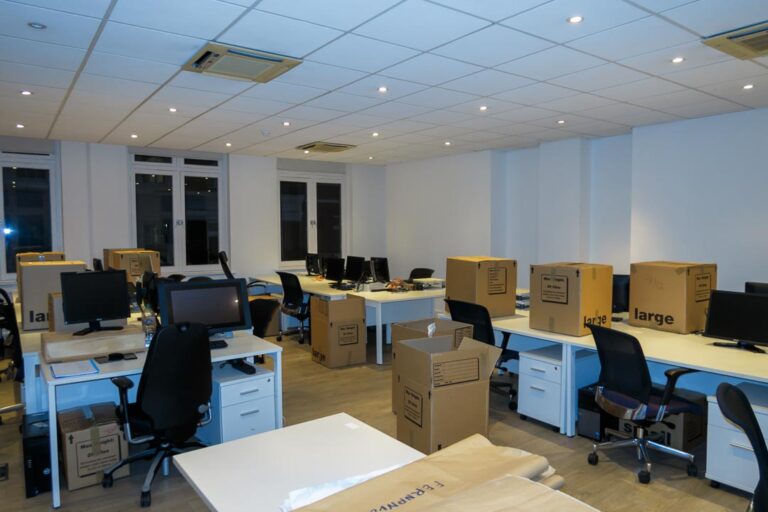Moving Your Office in London? Here’s How to Make It a Smooth Transition
Relocating your office can mark an exciting new chapter for your business—growth, a better location, or upgraded facilities. But if not managed properly, it can also bring disruption, downtime, and frustration. Planning a successful office relocation in London requires careful strategy, clear communication, and the right professional support.
London’s fast pace, traffic congestion, and building regulations present unique challenges for office moves. Whether you’re relocating a small start-up or a large corporate team, this guide will help you navigate the move with confidence and minimal disruption.
Step 1: Set Clear Objectives and a Realistic Timeline
An office move isn’t just about packing boxes and transporting desks. It involves people, equipment, technology, and day-to-day business operations. Begin by defining:
- Why you’re moving (expansion, lease expiry, cost savings)
- What success looks like (minimal downtime, improved layout, employee satisfaction)
- When you want the move completed by
A timeline is essential. Start planning at least 3–6 months in advance for a small office and up to a year for larger operations. Include deadlines for tasks like IT relocation, utility changes, and notifying stakeholders.
Step 2: Assemble a Relocation Team
You’ll need a dedicated internal team to handle the planning and execution. This should include:
- A project manager to oversee the process
- IT staff to manage equipment and infrastructure
- HR or admin reps to communicate with employees
- Department leads to coordinate team-specific needs
Assign clear responsibilities and hold regular check-ins to ensure the move stays on track.
Step 3: Hire a Professional Office Removal Company
A successful office removal in London hinges on working with a trusted, experienced moving company. Look for movers that specialize in commercial relocations and understand the challenges of London logistics.
Your chosen removal company should offer:
- A pre-move site survey
- Packing and labeling services
- IT and server relocation
- Office furniture dismantling and reassembly
- Weekend or after-hours moving to minimize business disruption
- Full insurance coverage
Ask for a detailed quote and ensure all services are clearly outlined.
Step 4: Audit and Declutter Your Equipment
Before moving, take stock of everything—furniture, electronics, documents, and supplies. This is a great opportunity to:
- Upgrade outdated IT equipment
- Digitize paper files
- Dispose of or donate unused furniture
- Reduce the volume of items to be moved (saving time and cost)
Make a detailed inventory of what’s going, staying, or being replaced. This will also help your movers plan for proper handling and loading.
Step 5: Develop an IT & Communications Transition Plan
Your tech infrastructure is at the heart of your business operations. Any disruption to internet access, phones, or servers can halt productivity. Work closely with your IT team and removal company to:
- Back up all data before the move
- Dismantle and label equipment properly
- Arrange for reinstallation and testing at the new location
- Ensure internet and telecoms are active at the new office before move-in day
You may also want to relocate critical systems (e.g., servers) separately and securely.
Step 6: Communicate Clearly with Staff and Stakeholders
Keep your employees informed throughout the relocation process. Clear communication reduces stress, builds buy-in, and avoids confusion. Announce:
- The reason for the move
- Key dates and deadlines
- How the move will affect their day-to-day work
- What’s expected from each team during the transition
Provide regular updates and allow time for feedback and questions. Also inform clients, suppliers, banks, and service providers about your new address and any changes to operations.
Step 7: Prepare the New Office for Day One
Don’t wait until move-in day to start thinking about the new space. In the weeks leading up to the move, coordinate:
- Cleaning and maintenance
- Internet and phone installation
- Furniture layout and signage
- Health and safety compliance
- Security access and alarms
Conduct a walkthrough before move-in to check that everything’s ready for your team. The goal is to hit the ground running with minimal disruption to your business.
Step 8: Conduct a Post-Move Review
Once the move is complete, take time to reflect. Ask:
- Did the move go according to plan?
- Were there any unexpected challenges?
- How did employees feel about the transition?
- Is there anything you’d do differently next time?
Gather feedback from your team and your movers to fine-tune your relocation process for the future. Small improvements can make a big difference in efficiency and employee satisfaction.
Final Thoughts
A well-planned office removal in London doesn’t just move desks—it supports business continuity, boosts morale, and sets the tone for your company’s next chapter. By starting early, involving the right people, and working with experienced professionals, you can turn a complex process into a smooth and rewarding one.
Relocating your office is more than a logistics challenge—it’s an opportunity to refresh your work environment, energize your team, and optimize how your space serves your business goals.


